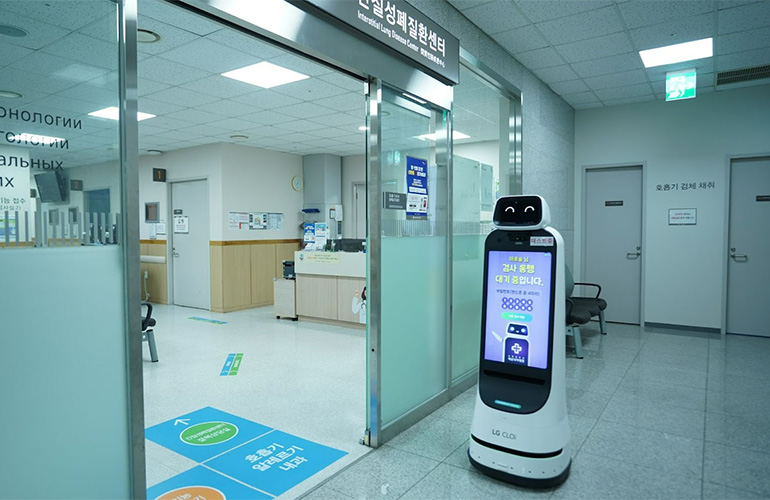Listen to this article


An LG CLOi guide robot waiting for a patient in front of the respiratory examination room. | Source: Bigwave Robotics
Bigwave Robotics Inc. this week launched its robot-as-a-service, or RaaS, model for hospitals. The Seoul, South Korea-based automation integrator said this marks a significant step toward the digital transformation of healthcare services.
The program allows hospitals to assign non-medical tasks such as delivery, guidance, and cleaning to service robots, with a central system managing the operations. Bigwave said its RaaS package includes providing the most suitable robots for each hospital, setting up deployment, and creating work scenarios.
The company, also known as My Robot Solution, has already initiated services based on robot usage at several hospitals. These include Hallym University Sacred Heart Hospital, Gyeonggi Provincial Medical Center Suwon Hospital, and Hallym University Kangnam Sacred Heart Hospital.
Hospitals need robots to keep up with patient demand
Hospitals must maintain a high level of cleanliness, transport various medications and specimens, and assist with visitor navigation, noted Bigwave Robotics. The COVID-19 pandemic exacerbated staffing shortages in hospitals, while aging populations have led to an increased number of patients seeking medical care. These challenges have driven the need for robotic solutions, the company said.
Bigwave Robotics offers RaaS for industries including logistics, manufacturing, and service. Its robotic offerings include cleaning robots, guide robots, delivery robots, serving robots, industrial robot arms, collaborative robots, autonomous mobile robots (AMRs). The company also offers grippers and other peripheral parts.
Bigwave said it is interested in automating a number of tasks within healthcare facilities. For instance, the company claimed that its robots are more efficient than humans in maintaining hospital cleanliness around the clock.
Similarly, it said delivery robots are better suited to transporting specimens and medications on time, rather than nurses or other hospital workers who could instead get more face time with patients.
In addition, for first-time visitors or elderly patients, Bigwave said its robots can provide reliable guidance in a world where contactless services have become more prevalent since the pandemic. This way, patients can feel reassured and navigate a hospital without fear by following the robot’s directions.

A diagram breaks down how smart hospital RaaS will work. Source: Bigwave Robotics
Bigwave Robotics helps hospitals pick the right robots
Finding a hospital robot and getting it set up and ready to go, however, can be daunting tasks. Even basic service robots require more than just a power switch to deliver satisfactory performance.
The right robot must be selected for the task, trained in the operating environment, and given specific instructions. Hospitals with little to no experience in robot management may struggle from the outset, noted Bigwave Robotics.
Choosing and deploying the right robots and preparing the work environment necessitates the involvement of robotics experts, but finding such specialists can be difficult for hospitals, it said. High costs are another barrier, as hospitals with no prior experience may find it challenging to justify the investment.
Addressing problems such as malfunctions, can pose further difficulties. All of these reasons led Bigwave Robotics to offer RaaS to work with hospitals on their deployments. It said it expects to have robots in 10 hospitals within the year.
The company’s SOLink workflow engine is a multi-robot control platform. It allows for standardized robot languages, robot-infrastructure integration, and easy creation of complex scenarios, it said.
In August, Bigwave Robotics deployed its cleaning robots at the Incheon International Airport in Korea. The company is deploying eight Gausium Ecobot VC40 units for dry cleaning and four large SC75 units capable of both dry and wet cleaning.
The VC40s are designated for carpeted floors, while the SC75s handle marble floors. SOLlink can remotely assign cleaning areas and schedule cleanings at specified times, said Bigwave.





GIPHY App Key not set. Please check settings